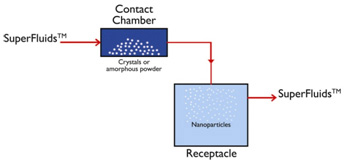For oral/subcutaneous/pulmonary delivery of hydrophobic drugs, proteins, peptides, genes and vaccine antigens
Conventional Protein Nanoparticles Techniques and their Drawbacks
An ongoing concern in the pharmaceutical and biotechnology industries is the administration of a steady dosage of a therapeutic agent. In the formulation of controlled release therapeutics, it is frequently desirable to disperse the material into very fine, uniform particles. Such particles may then be advantageously incorporated into controlled-release delivery vehicles such as polymeric nanospheres/microspheres, depots or implantable devices, or delivered to the lungs as an aerosol. With proteinaceous therapeutics, the generation of such fine particles is particularly problematic with several drawbacks.
* If on a mobile device, please swipe left or right to view the entire table.
| Method | Drawbacks |
| Mechanical Milling | Protein denaturation by mechanical shear and/or heat |
| Spray Drying | Protein denaturation at the gas-liquid interface and/or heat for solvent vaporization |
| Fluid Energy Grinding | High-velocity gas can yield electrostatically charged powders, size reduction inefficient for soft proteinaceous powders |
| Lyophilization | Broad size distribution, protein-specific applicability, and protocols |
| Anti-Solvent Precipitation | Protein denaturation by organic, solvents, solvent removal, solvent residuals, particle size control difficult |
| Salt Precipitation | Protein specific applicability, salt removal or contamination, particle size control difficult |
A Solution – The PNP Process
 Protein Nanoparticles (PNP) technology platform utilizes the expansive energy of supercritical fluids with or without polar cosolvents (SuperFluids™ [SFS]) to disaggregate or comminute protein crystals and amorphous powders into monodisperse nanoparticles [US Patent].
Protein Nanoparticles (PNP) technology platform utilizes the expansive energy of supercritical fluids with or without polar cosolvents (SuperFluids™ [SFS]) to disaggregate or comminute protein crystals and amorphous powders into monodisperse nanoparticles [US Patent].
The PNP process uses SuperFluids™ to form small protein particles without first dissolving the material in a liquid solvent. As such, the target therapeutic retains full activity and is devoid of residual processing chemicals such as solvents, salts or surfactants. The energy necessary for the size reduction is derived from a rapid depressurization of the SuperFluids™. The low temperature generated by the expansion of the supercritical fluid helps to preserve the chemical integrity of the protein and is an advantage over conventional grinding processes that generate heat.
Benefits/Advantages of the PNP Process
- Forms monodisperse protein particles [0.5 to 5 micron (μm)] without having to first dissolve the protein in a liquid solvent
- Robust for a wide range of enzymes & sizes
- High retention with possible enhancement of bioactivity
- Not constrained by limited solubility in benign solvents such as ethanol that may be used with other supercritical fluid techniques, and the utilization of large volumes of liquids that limits other techniques such as spray drying
- Produces a Joule-Thompson cooling effect, and thus avoids heat associated with milling techniques that can cause protein degradation and contamination by metal particles
- Improves processes and products in the area of drug delivery, e.g., more uniform and extended-release of therapeutic from microsphere carriers or more uniform aerosol formulations
- Improves product quality with no residual solvent or surfactant contamination
- Environmental advantages due to the elimination of the use of organic solvents.
- Physical, single step, a single-pass process that is scalable
- Improves process economics due to simplification of the process train
Applications of the PNP Process
Aphios’ protein nanoparticles (PNP) process can be used for oral/subcutaneous/pulmonary delivery of hydrophobic drugs such as paclitaxel, camptothecin, and betulinic acid, proteins such as insulin, calcitonin and human growth hormone, peptides, genes and vaccine antigens for anthrax, HIV and influenza.